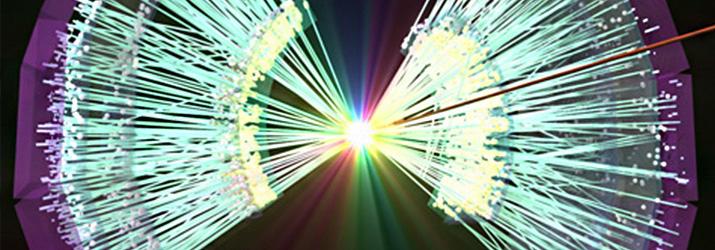

Using the Edwards Accelerator and National Labs
At the scale of nuclei, about 10,000 times smaller than atoms, we encounter the strong force that holds together protons and neutrons in the nucleus and also holds together quarks inside the proton and neutron. The strong force is about 100 times bigger than the electric forces that bind electrons to atoms, and so it requires powerful accelerators to study it.
The Edwards Accelerator Lab , located on campus at Ohio University, and national accelerator laboratories are used by faculty and students to study the properties of both the strong and the weak nuclear forces. Whether trying to discover new types of particles or learning what goes on inside supernova explosions, the goal of this research is to learn about the fundamental forces that bind nuclei and particles.
Faculty
- Dr. Carl Brune : Experimental Nuclear Astrophysics and Weakly-bound States of Nuclei
- Dr. Chaden Djalali: Experimental Nuclear and Particle Physics
- Dr. Christian Drischler : Theoretical Nuclear Physics, Chiral Effective Field Theory, and Structure of Neutron Stars
- Dr. Charlotte Elster : Few-Nucleon Systems, Effective Field Theories and Computational Physics
- Dr. Justin Frantz : Experimental Relativistic Heavy Ion Physics and Photon-Jet Correlations
- Dr. Paul King : Experimental Particle Physics and Parity Violation in Electron Scattering
- Dr. Thomas Massey : Experimental Nuclear Physics and Nuclear Structure
- Dr. Daniel Phillips : Theoretical Nuclear Physics and Chiral Effective Field Theory
- Dr. Madappa Prakash : Theoretical Nuclear Physics and Structure of Neutron Stars
- Dr. Andrea Richard : Experimental Nuclear Astrophysics, Rare Isotope Beam Studies, and Gamma-ray Spectroscopy
- Dr. Julie Roche : Experimental Particle Physics: Hadron Structure
- Dr. Alexander Voinov : Experimental Nuclear Physics and Nuclear Structure
Associated Faculty and Staff
- Dr. Heather Crawford : Low-energy Nuclear Structure of Exotic Nuclei, Gamma-ray Spectroscopy and Gamma-ray Detection Arrays
- Dr. Steven Grimes : Experimental Nuclear Physics and Level Densities of Nuclei
- Dr. Gabriela Popa (Zanesville campus): Theoretical Nuclear Physics
- Dr. Cody Parker : Experimental nuclear physics, neutron-induced reactions, and applications
